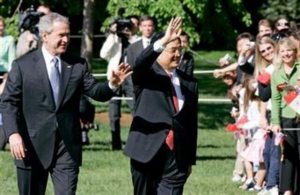When I heard the NPR report of all the pomp and ceremony and symbolism on display during Chinese President Hu Jintao’s visit to the White House yesterday, I expected the news service photos to show a classic Sforzian set, with all the carefully calibrated money shots: statesman-like profiles while the two men review the troops; dual podiums with a Sforzian Background of artfully fluffed flags. You know, like the kind of thing White House Prod. did when they went to China. And Mongolia.
Given the amount of preproduction for these events–which are designed to exist as and generate media, not as live experiences, remember–I was immediately suspicious when I heard a Falun Gong protestor turned up. And that she wasn’t hustled off for several minutes. And that she was a print reporter on the TV camera platform.
[After all, if there’s one thing Bush Republicans have demonstrated their competence in, it’s their ability to pack a crowd and the ruthless efficiency with which they dispatch any off-message disruptors.]
But in fact, the Hu Jintao slideshow on Yahoo News [my usual source for Sforza’s work, and the source of these images] totally shocked me. There were a couple of very tight portraits, but there was absolutely none of Sforza’s signature preset money shots. None.

The event was certainly large and stagey, with throngs of supporters and colonial marching bands and flags everywhere, but Sforza’s strength in imagecraft is in designing camera positions and backdrops and foregrounds that give photographers and cameramen gorgeous, easily read shots that are so easy to take, journalists don’t mind leaving the editorial decisions to the White House. There was absolutely none of that in the Hu-Bush images.

If anything, they showed the exact opposite. The images are tight and indistinct, shot from too close or too low. And the backgrounds are almost random.
Even without knowing the Falun Gong protestor was frogmarched out in front of everybody, it was obvious that WHP intended for this event to look different and to be read differently. [They knew it was being carried live in China.] Every other aspect of production seemed to be in place; so I can’t imagine Sforza falling asleep on the shot composition. The only other explanation is that every wire service sent an intern to shoot the event. And you’d have to be a pretty big conspiracy nut to believe that.

George Bush giving a tug to Chinese President Hu Jintao, Apr 20, 2006, image: Jim Bourg/Reuters via NYT
Add to that the announcer calling China the “Republic of China,” and the images of Bush tugging at Hu’s sleeve to stop him from going down the wrong stairs, an atypical gesture he had to know would set the shutters clicking, and there is no doubt in my mind that the event produced exactly the images the White House expected it would.
The White House went through all the diplomatic motions of producing a showy event, then they fed reporters stories of the Chinese penchant for showy events and symbolism, including their request for a state dinner, which was rejected. And then they sabotaged the whole thing in a few crucial but plausibly deniable ways to send a message that may or may not have ended up on Chinese TV.
And to remind China who’s still the boss around here.
Skip to content
the making of, by greg allen
